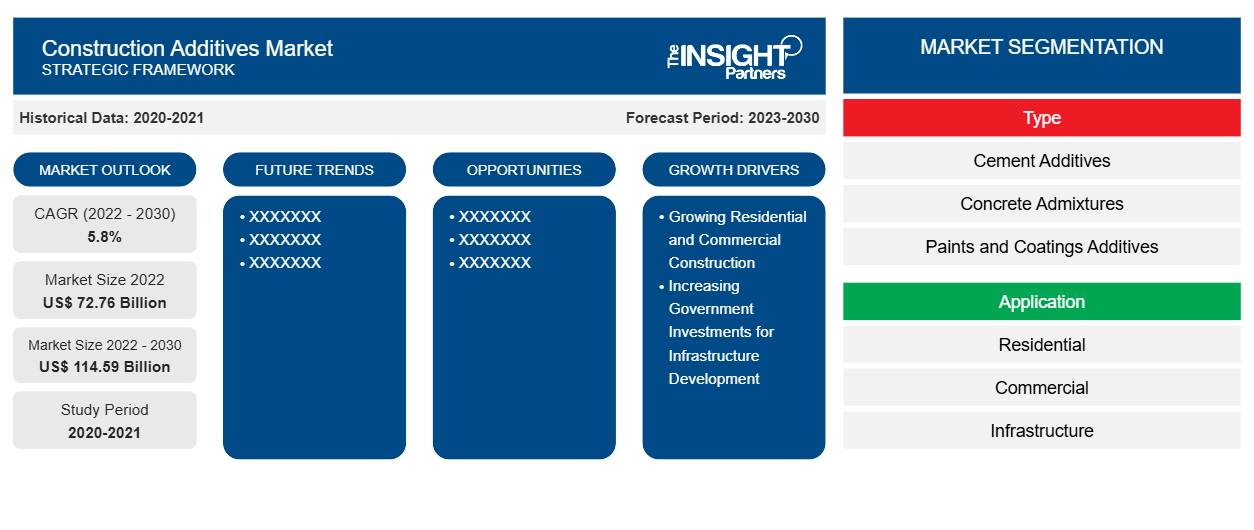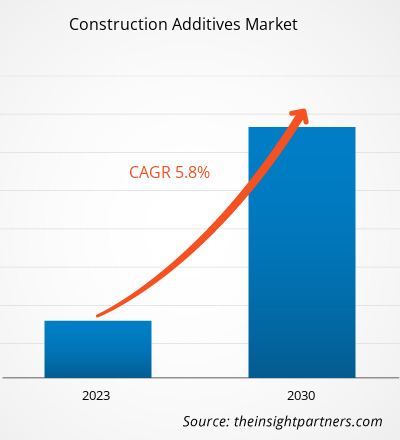[研究报告] 2022年建筑添加剂市场规模价值为 727.6 亿美元,预计到 2030 年将达到 1145.9 亿美元;预计 2022 年至 2030 年的复合年增长率为 5.8%。
市场洞察和分析师观点:
建筑添加剂包括水泥添加剂、混凝土外加剂、塑料添加剂、沥青添加剂、油漆和涂料添加剂、粘合剂和密封剂添加剂、玻璃添加剂和陶瓷添加剂。这些材料用于提高建筑产品的质量和性能。它们还有助于实现某些理想的特性,例如提高强度、耐久性和可加工性。市场上有各种粉末和液体建筑添加剂产品可供选择,它们可以配制创新产品。推动市场增长的主要因素是住宅和商业建筑的增长以及政府对基础设施建设的投资增加。政府支持的基础设施项目包括道路、水坝、桥梁、隧道、港口、机场路面和高速公路。所有这些因素都促进了建筑添加剂市场的发展
增长动力和挑战:
住宅和商业建筑的增长以及政府对基础设施建设投资的增加是推动市场发展的关键因素之一。根据欧洲建筑业联合会的数据,2022 年法国非住宅建筑投资估计为 584.9 亿美元。2023 年,DEEM Enterprises LLC宣布计划斥资 27 亿美元在美国新泽西州一处前机场旧址上建造一条一级方程式赛车场、住宅和购物中心。政府机构不断增加的投资导致基础设施建设增加。
2021 年 11 月,美国政府批准了一项 1.2 万亿美元的基础设施法案,以协助联邦政府对各种基础设施项目的投资。此外,到 2023 年,建筑支出预计将增长 5.5%。这些举措产生了对建筑服务、化学品和材料的需求。世界各国政府在基础设施建设方面的投资和努力不断增加,推动了市场的发展。不断增长的建设和基础设施建设投资正在刺激对不同建筑化学品和材料的需求,从而推动建筑添加剂市场的发展。
原材料价格的波动可能会对市场产生阻碍作用。乳化剂、再生剂和抗剥落剂等建筑添加剂都是间接从原油中提取的。运输和供应链中断、原油需求上升、原材料价格上涨以及由于 COVID-19 疫情导致的原材料供应有限,导致石油产品价格上涨。由于全球经济状况波动导致原油价格上涨,进一步推高了石油衍生添加剂的价格。石油产品和其他原材料价格上涨可能会给产品的利润率带来压力,这对建筑添加剂市场的增长构成了挑战。
定制此报告以满足您的需求
您可以免费定制任何报告,包括本报告的部分内容、国家级分析、Excel 数据包,以及为初创企业和大学提供优惠和折扣
- 获取此报告的关键市场趋势。这个免费样品将包括数据分析,从市场趋势到估计和预测。
报告细分和范围:
“2030 年全球建筑添加剂市场分析与预测”是一项专业而深入的研究,重点关注全球市场趋势和增长机会。该报告旨在提供市场概述,并按类型和应用对市场进行详细细分。市场在最近经历了高增长,预计在预测期内将继续保持这一趋势。该报告提供了全球建筑添加剂消费的关键统计数据。此外,全球建筑添加剂市场报告对影响全球市场表现的各种因素进行了定性评估。该报告还包括对市场主要参与者及其关键战略发展的全面分析。还包括对市场动态的几项分析,以帮助确定关键驱动因素、建筑添加剂市场趋势和有利可图的机会,进而有助于确定主要收入来源。
建筑添加剂市场预测是根据各种二手和一手研究结果(如主要公司出版物、协会数据和数据库)估算的。此外,生态系统分析和波特五力分析提供了对市场的 360 度视角,有助于了解整个供应链和影响市场表现的各种因素。
节段分析:
全球建筑添加剂市场根据类型和应用进行细分。根据类型,市场细分为水泥添加剂、混凝土外加剂、油漆和涂料添加剂、粘合剂和密封剂添加剂、塑料添加剂、沥青添加剂等。水泥添加剂部分在 2022 年占据了建筑添加剂市场的很大份额。水泥添加剂包括研磨助剂、强度增强剂和性能增强剂。研磨助剂是具有几个关键优势的添加剂,例如提高生产率和提高细度。水泥中添加了各种强度增强剂,以提高其机械强度,通常是通过化学活化来保持水泥结构和表面的完整性。水泥添加剂在基础设施开发中的应用预计将推动市场发展。
根据应用,市场细分为住宅、商业、基础设施和其他。住宅部分在 2022 年占据了相当大的建筑添加剂市场份额。由于城市化进程加快,对住宅建筑的需求不断增加,住宅部门对不同类型的建筑添加剂的需求激增。在印度,2015 年启动的“全民住房计划”(也称为 Pradhan Mantri Awas Yojana(城市)计划)旨在到 2024 年为城市地区的所有人提供住房。住宅建筑行业投资和开发活动的增长归因于全球不同国家人口的增长和城市化。此外,许多国家的住房计划和政府的优惠政策导致了住宅建筑的建立,预计这将在预测期内推动对建筑添加剂的需求。
区域分析:
该报告详细概述了五大主要地区的市场——北美、欧洲、亚太地区 (APAC)、中东和非洲 (MEA) 以及南美和中美。在收入方面,亚太地区占据建筑添加剂市场的主导地位,2022 年的价值超过 350 亿美元。根据国际贸易管理局的数据,中国“十四五”期间 (2021-2025 年) 基础设施总投资预计将达到约 4.2 万亿美元。2022 年,国家发展和改革委员会 (NDRC) 和交通运输部 (中国) 公布了《国家公路网规划》文件,旨在到 2035 年建成功能齐全、高效、绿色、智能、安全的现代化公路网。该计划还包括修建 461,000 公里的高速公路,其中包括 162,000 公里的高速公路。预计在预测期内,印度和中国等几个亚洲经济体的基础设施建设和不断增长的住房项目将推动建筑添加剂市场的发展。
预计到 2030 年,欧洲建筑添加剂市场规模将达到约 240 亿美元。欧洲是最大的建筑材料生产国之一,由向当地和区域市场供应建筑材料的中小型企业 (SME) 经营。欧洲基础设施建设中可持续建筑添加剂的使用越来越多,预计将推动建筑添加剂市场的增长。预计从 2022 年到 2030 年,中东和非洲的复合年增长率将达到约 6%。由于中东和非洲的基础设施项目、可持续建筑和工业化激增,对建筑材料的需求增加,推动了对建筑和建筑材料的需求。由于旅游业的发展和移民人口的增加,该地区的商业基础设施建设也出现了激增。城市人口的增加导致对半城市和城市私人住宅建筑的需求激增,促使政府投资建筑业。
建筑添加剂市场区域洞察
Insight Partners 的分析师已详尽解释了预测期内影响建筑添加剂市场的区域趋势和因素。本节还讨论了北美、欧洲、亚太地区、中东和非洲以及南美和中美洲的建筑添加剂市场细分和地理位置。

- 获取建筑添加剂市场的区域特定数据
建筑添加剂市场报告范围
| 报告属性 | 细节 |
|---|---|
| 2022 年市场规模 | 727.6亿美元 |
| 2030 年的市场规模 | 1145.9亿美元 |
| 全球复合年增长率(2022 - 2030 年) | 5.8% |
| 史料 | 2020-2021 |
| 预测期 | 2023-2030 |
| 涵盖的领域 | 按类型
|
| 覆盖地区和国家 | 北美
|
| 市场领导者和主要公司简介 |
|
建筑添加剂市场参与者密度:了解其对业务动态的影响
建筑添加剂市场正在快速增长,这得益于最终用户需求的不断增长,这些需求源于消费者偏好的不断变化、技术进步以及对产品优势的认识不断提高等因素。随着需求的增加,企业正在扩大其产品范围,进行创新以满足消费者的需求,并利用新兴趋势,从而进一步推动市场增长。
市场参与者密度是指在特定市场或行业内运营的企业或公司的分布情况。它表明在给定市场空间中,相对于其规模或总市场价值,有多少竞争对手(市场参与者)存在。
在建筑添加剂市场运营的主要公司有:
- WR Grace & Co
- 克里索 公司
- 陶氏化学公司
- 巴斯夫 SE
- 西麦斯公司 SAB de CV
免责声明:上面列出的公司没有按照任何特定顺序排列。

- 了解建筑添加剂市场主要参与者概况
行业发展和未来机遇:
以下列出了建筑添加剂市场主要参与者采取的各种举措:
- 2021 年 4 月,陶氏建筑化学品扩大其业务范围,聘请 JNS SmithChem LLC作为东南地区授权经销商,业务范围覆盖缅因州、佛蒙特州、新罕布什尔州、马萨诸塞州、罗德岛州、康涅狄格州、纽约州和宾夕法尼亚州。
- 2023年7月,海德堡材料庆祝北美第二大水泥厂开业。
- 2023 年 7 月,西卡股份公司投资宏观纤维,以满足美国对可持续混凝土快速增长的需求。
竞争格局和重点公司:
住友精化株式会社、日本触媒株式会社、三洋化成株式会社、巴斯夫欧洲公司、赢创工业股份公司、LG 化学有限公司、卫星化学有限公司、花王公司、宜兴丹森科技和松原工业集团是建筑添加剂市场报告中介绍的主要参与者。全球市场参与者专注于提供高质量的产品以满足客户需求。
- 历史分析(2 年)、基准年、预测(7 年)及复合年增长率
- PEST 和 SWOT 分析
- 市场规模价值/数量 - 全球、区域、国家
- 行业和竞争格局
- Excel 数据集


- Underwater Connector Market
- Excimer & Femtosecond Ophthalmic Lasers Market
- Fill Finish Manufacturing Market
- Cosmetic Bioactive Ingredients Market
- Terahertz Technology Market
- Ketogenic Diet Market
- Advanced Planning and Scheduling Software Market
- Diaper Packaging Machine Market
- Portable Power Station Market
- High Speed Cable Market

Report Coverage
Revenue forecast, Company Analysis, Industry landscape, Growth factors, and Trends

Segment Covered
This text is related
to segments covered.

Regional Scope
North America, Europe, Asia Pacific, Middle East & Africa, South & Central America

Country Scope
This text is related
to country scope.
常见问题
Growing residential and commercial construction, and increasing government investments for infrastructure development, are some of the key driving factors for the construction additives market.
The strategic development initiatives by key market players offer lucrative growth opportunities to the global construction additives market during the forecast period.
Based on application, infrastructure is the fastest-growing segment. The surging investments in the infrastructure sector and growing expenditure on transport infrastructure are mainly driving the demand for construction additives.
Asia Pacific construction additives market is expected to surge due to government investments in infrastructure development, including roadways, highways, bridges and airport. Low labor costs, availability of specialized building materials, and research & development cost in the Asian countries, is fueling the demand for construction additives.
Based on the type, the cement additives segment accounted for the largest revenue share. In the cement manufacturing process, adding cement additives helps improve cement grinding efficiency and narrow particle size distributions. The growing demand for cement used in infrastructure development across the globe drives the construction additives market.
Trends and growth analysis reports related to Chemicals and Materials : READ MORE..
The List of Companies - Construction Additives Market
- W. R. Grace & Co
- Chryso SAS
- Dow Inc
- BASF SE
- Cemex SAB de CV
- Fosroc International Ltd
- CICO Technologies Ltd
- Sika AG
- Evonik Industries AG
- Mapei SpA
The Insight Partners performs research in 4 major stages: Data Collection & Secondary Research, Primary Research, Data Analysis and Data Triangulation & Final Review.
- Data Collection and Secondary Research:
As a market research and consulting firm operating from a decade, we have published and advised several client across the globe. First step for any study will start with an assessment of currently available data and insights from existing reports. Further, historical and current market information is collected from Investor Presentations, Annual Reports, SEC Filings, etc., and other information related to company’s performance and market positioning are gathered from Paid Databases (Factiva, Hoovers, and Reuters) and various other publications available in public domain.
Several associations trade associates, technical forums, institutes, societies and organization are accessed to gain technical as well as market related insights through their publications such as research papers, blogs and press releases related to the studies are referred to get cues about the market. Further, white papers, journals, magazines, and other news articles published in last 3 years are scrutinized and analyzed to understand the current market trends.
- Primary Research:
The primarily interview analysis comprise of data obtained from industry participants interview and answers to survey questions gathered by in-house primary team.
For primary research, interviews are conducted with industry experts/CEOs/Marketing Managers/VPs/Subject Matter Experts from both demand and supply side to get a 360-degree view of the market. The primary team conducts several interviews based on the complexity of the markets to understand the various market trends and dynamics which makes research more credible and precise.
A typical research interview fulfils the following functions:
- Provides first-hand information on the market size, market trends, growth trends, competitive landscape, and outlook
- Validates and strengthens in-house secondary research findings
- Develops the analysis team’s expertise and market understanding
Primary research involves email interactions and telephone interviews for each market, category, segment, and sub-segment across geographies. The participants who typically take part in such a process include, but are not limited to:
- Industry participants: VPs, business development managers, market intelligence managers and national sales managers
- Outside experts: Valuation experts, research analysts and key opinion leaders specializing in the electronics and semiconductor industry.
Below is the breakup of our primary respondents by company, designation, and region:

Once we receive the confirmation from primary research sources or primary respondents, we finalize the base year market estimation and forecast the data as per the macroeconomic and microeconomic factors assessed during data collection.
- Data Analysis:
Once data is validated through both secondary as well as primary respondents, we finalize the market estimations by hypothesis formulation and factor analysis at regional and country level.
- Macro-Economic Factor Analysis:
We analyse macroeconomic indicators such the gross domestic product (GDP), increase in the demand for goods and services across industries, technological advancement, regional economic growth, governmental policies, the influence of COVID-19, PEST analysis, and other aspects. This analysis aids in setting benchmarks for various nations/regions and approximating market splits. Additionally, the general trend of the aforementioned components aid in determining the market's development possibilities.
- Country Level Data:
Various factors that are especially aligned to the country are taken into account to determine the market size for a certain area and country, including the presence of vendors, such as headquarters and offices, the country's GDP, demand patterns, and industry growth. To comprehend the market dynamics for the nation, a number of growth variables, inhibitors, application areas, and current market trends are researched. The aforementioned elements aid in determining the country's overall market's growth potential.
- Company Profile:
The “Table of Contents” is formulated by listing and analyzing more than 25 - 30 companies operating in the market ecosystem across geographies. However, we profile only 10 companies as a standard practice in our syndicate reports. These 10 companies comprise leading, emerging, and regional players. Nonetheless, our analysis is not restricted to the 10 listed companies, we also analyze other companies present in the market to develop a holistic view and understand the prevailing trends. The “Company Profiles” section in the report covers key facts, business description, products & services, financial information, SWOT analysis, and key developments. The financial information presented is extracted from the annual reports and official documents of the publicly listed companies. Upon collecting the information for the sections of respective companies, we verify them via various primary sources and then compile the data in respective company profiles. The company level information helps us in deriving the base number as well as in forecasting the market size.
- Developing Base Number:
Aggregation of sales statistics (2020-2022) and macro-economic factor, and other secondary and primary research insights are utilized to arrive at base number and related market shares for 2022. The data gaps are identified in this step and relevant market data is analyzed, collected from paid primary interviews or databases. On finalizing the base year market size, forecasts are developed on the basis of macro-economic, industry and market growth factors and company level analysis.
- Data Triangulation and Final Review:
The market findings and base year market size calculations are validated from supply as well as demand side. Demand side validations are based on macro-economic factor analysis and benchmarks for respective regions and countries. In case of supply side validations, revenues of major companies are estimated (in case not available) based on industry benchmark, approximate number of employees, product portfolio, and primary interviews revenues are gathered. Further revenue from target product/service segment is assessed to avoid overshooting of market statistics. In case of heavy deviations between supply and demand side values, all thes steps are repeated to achieve synchronization.
We follow an iterative model, wherein we share our research findings with Subject Matter Experts (SME’s) and Key Opinion Leaders (KOLs) until consensus view of the market is not formulated – this model negates any drastic deviation in the opinions of experts. Only validated and universally acceptable research findings are quoted in our reports.
We have important check points that we use to validate our research findings – which we call – data triangulation, where we validate the information, we generate from secondary sources with primary interviews and then we re-validate with our internal data bases and Subject matter experts. This comprehensive model enables us to deliver high quality, reliable data in shortest possible time.


 获取此报告的免费样本
获取此报告的免费样本